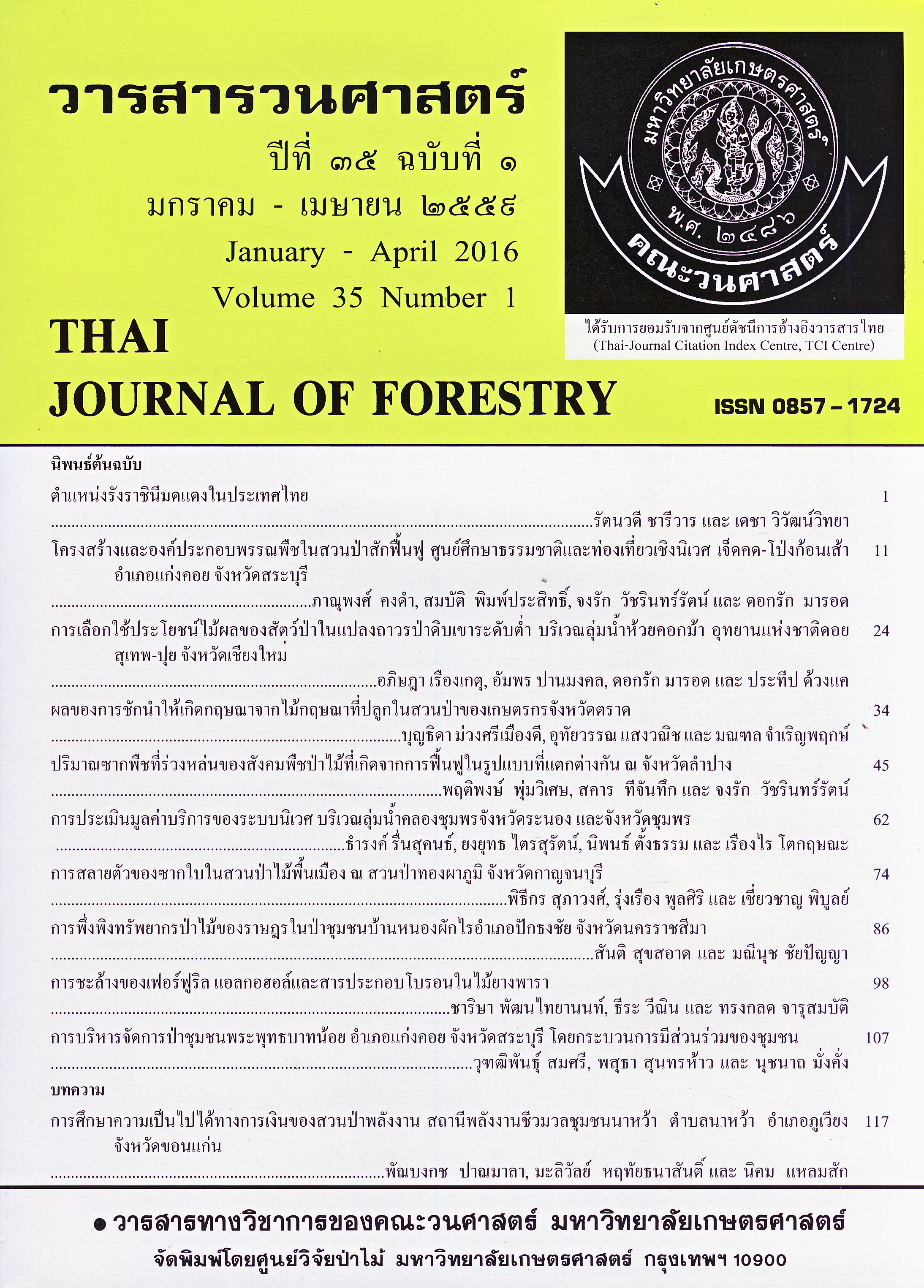ผลของการชักนำให้เกิดกฤษณาจากไม้กฤษณาที่ปลูกในสวนป่า ของเกษตรกรจังหวัดตราด
Main Article Content
บทคัดย่อ
การศึกษานี้มีวัตถุประสงค์เพื่อต้องการทราบปริมาณการเกิดกฤษณา รวมทั้งปริมาณและคุณภาพของน้ำมันที่ได้จากการชักนำไม้กฤษณาที่ปลูกในสวนป่าของเกษตรกรในพื้นที่จังหวัดตราด โดยทำการเปรียบเทียบปริมาณการเกิดกฤษณา (agarwood) ในเนื้อไม้จากวิธีการชักนำที่แตกต่างกัน 4 วิธีการ จากนั้นนำชิ้นไม้ที่มีกฤษณาที่ทำการคัดแยกออกมาแล้วนั้นไปทำการกลั่นเพื่อหาปริมาณน้ำมันกฤษณา (agarwood oil) โดยใช้วิธีการกลั่นที่แตกต่างกัน 3 วิธีการ ผลของการชักนำให้เกิดกฤษณาโดยวิธีการชักนำทั้ง 4 วิธีการของเกษตรในจังหวัดตราดพบว่า วิธีการชักนำที่ 4 ที่กระทำในต้นกฤษณาอายุ 12 ปี ด้วยการเจาะรูรอบลำต้นแล้วตอกไม้ไผ่ที่เคลือบด้วยสารกระตุ้นไม่เปิดเผยสูตรลงไปในรู ทิ้งไว้นาน 16 เดือน เป็นวิธีการที่ทำให้ได้กฤษณาในเนื้อไม้มากที่สุด คิดเป็นร้อยละ 32 ของน้ำหนัก(w/w) เนื้อไม้ทั้งต้น และเมื่อนำไปกลั่นด้วยวิธีการกลั่นที่ III คือ ใช้หม้อต้มที่ทำด้วยทองแดง มีท่อควบแน่นทำด้วยสแตนเลสที่วางไว้ในแนวนอนและแช่อยู่ในน้ำ ได้ปริมาณน้ำมันกฤษณามากที่สุดเท่ากับ 0.062 โตร่า (0.7 กรัม) ต่อกิโลกรัม รวมทั้งยังมีคุณภาพอยู่ในเกณฑ์ดี ซึ่งตัดสินจากราคารับซื้อของพ่อค้าที่พิจารณาจากเกณฑ์เรื่องกลิ่นและ
ความคงทนของกลิ่นของน้ำมันกฤษณา โดยมีราคารับซื้อเท่ากับ 4,200 บาทต่อโตร่า
Downloads
Article Details
ข้าพเจ้าและผู้เขียนร่วม (ถ้ามี) ขอรับรองว่า ต้นฉบับที่เสนอมานี้ยังไม่เคยได้รับการตีพิมพ์และไม่ได้อยู่ในระหว่างกระบวนการพิจารณาตีพิมพ์ลงในวารสารหรือสิ่งตีพิมพ์อื่นใด ข้าพเจ้าและผู้เขียนร่วม (ถ้ามี) ยอมรับหลักเกณฑ์และเงื่อนไขการพิจารณาต้นฉบับ ทั้งยินยอมให้กองบรรณาธิการมีสิทธิ์พิจารณาและตรวจแก้ต้นฉบับได้ตามที่เห็นสมควร พร้อมนี้ขอมอบลิขสิทธิ์ผลงานที่ได้รับการตีพิมพ์ให้แก่วารสารวนศาสตร์ คณะวนศาสตร์ มหาวิทยาลัยเกษตรศาสตร์ กรณีมีการฟ้องร้องเรื่องการละเมิดลิขสิทธิ์เกี่ยวกับภาพ กราฟ ข้อความส่วนใดส่วนหนึ่ง หรือ ข้อคิดเห็นที่ปรากฏในผลงาน ให้เป็นความรับผิดชอบของข้าพเจ้าและผู้เขียนร่วม (ถ้ามี) แต่เพียงฝ่ายเดียว และหากข้าพเจ้าและผู้เขียนร่วม (ถ้ามี) ประสงค์ถอนบทความในระหว่างกระบวนการพิจารณาของทางวารสาร ข้าพเจ้าและผู้เขียนร่วม (ถ้ามี) ยินดีรับผิดชอบค่าใช้จ่ายทั้งหมดที่เกิดขึ้นในกระบวนการพิจารณาบทความนั้น”
เอกสารอ้างอิง
Burkill, I.H. 1966. A dictionary of the economic products of the Malay Penninsula. Vol. I. Governments of Malaysia and Singapore, Ministry of Agriculture and Co-operative, Malaysia.
Eiadthong, W. 2007. Aquilaria rugosa (Thymelaeaceae): A new record for Thailand. The Thailand Natural Historical Museum J. 2: 63-66.
Eiadthong., W. 2009. Treatment techniques to stimulate incensed resinous wood formation of agarwood (Aquilaria crassna Pierre ex Lec.) by intentional wounding. Thai Journal of Forestry 28 (1): 1-16. (in Thai)
Eurlings, M and B. Gravendeel. 2003. Identification of agarwood (Aquilaria and Gyrinops) dry wood using trnL-trnF polymorphisms. (CD Rom). In First International Agarwood Conference. November 10-15, 2003. Vietnam.
Hou, D. 1960. Thymelaeaceae. pp.1-15. In Van Steenis, C.G.G.J. (ed.), Flora Malesiana Series I Vol. 6. Wolter-Noordhoff Publishing, Groningen,The Netherland.
Siripatanadilok, S., A. Chalermpongse and S. Sangthongpraow. 1991. Utilization and propagation of agarwood trees (Aquilaria spp.). Final Report,Department of Forest Biology, Faculty of Forestry, Kasetsart University.
Siripatanadilok, S. 2007. Species and trade of agarwood. Journal of Forest Management 1: 19-31. (in Thai)


